I. Ramos Arreguin (ed.) Automation and Robotics
Подождите немного. Документ загружается.

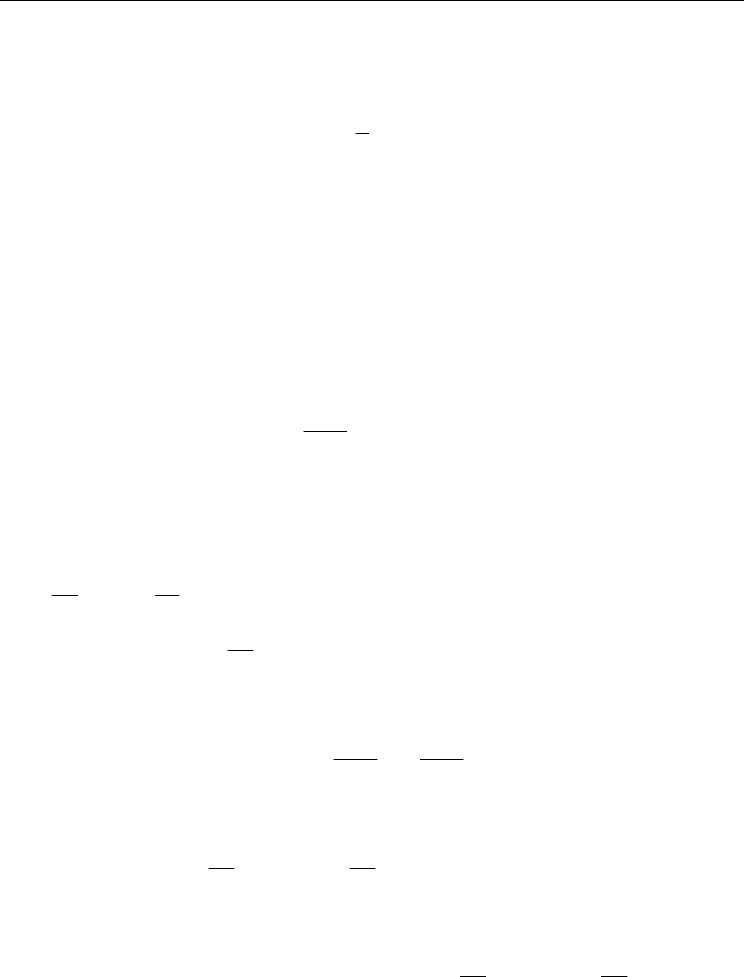
Nonlinear Control Law for Nonholonomic Balancing Robot
93
4.3 Proof of convergence of the control algorithm
Lets consider trajectories of the disturbed closed-loop system (12) and (13). We choose the
following Lyapunov-like function
ηηααηαα
eeeeeeeV
T
++=
2
)(
2
1
),,(
. (14)
Now we calculate the time derivative of
V
ηηαααα
eeeeeeV
T
+++= ))((
which along solutions of the closed-loop system (12)-(13) is equal to
ηαηαηηαααα
ηηηααααα
eKeeKeeKeeKeKKee
eKeeKMMeKeKeeeV
m
T
dp
m
T
mpd
11
22
2
*
21
1*
22
)1(
))()((
++−−−−−=
−+−−+=
−
. (15)
with parameters defined in the following way
()
[]
2211
*
21
1
*
221
,
cos
mm
p
m
KK
I
KMMK
α
==
−
, 1
2
−
+
=
dp
KKK
where
I
p
is a moment of inertia of the inverted pendulum. Then the time derivative of the V
function can be evaluated by the expression
))((
4
1)1(
))(()1(
24
))(()1(
213
2
222
2
111
2
2
2
2
213
2
222
2
111
22
2
2
22
2
2
213
2
222
2
111
22
2
ηηααηηαα
ηηααηηαααααα
ηηααηηαααα
eeeeKeKeKe
K
KeK
eeeeKeKeKeKeKee
K
ee
K
eeeeKeKeKeKeKKeeV
mmdp
mmdp
mmdp
+++−−
⎟
⎟
⎠
⎞
⎜
⎜
⎝
⎛
−−−−−≤
+++−−−−−
⎟
⎠
⎞
⎜
⎝
⎛
+−+=
+++−−−−−−≤
with
⎟
⎟
⎠
⎞
⎜
⎜
⎝
⎛
=
∀ 22113
cos
;
cos
max
m
p
m
p
K
I
K
I
K
αα
α
Using the same method of estimation, we can obtain the following formula
()()
011
2
1
2
1
2
222
2
111
2
2
2
2
2
3
≤−−−−
⎟
⎟
⎠
⎞
⎜
⎜
⎝
⎛
−−−
⎟
⎟
⎠
⎞
⎜
⎜
⎝
⎛
−−−≤
ηηαα
eKeKe
K
Ke
K
KV
mmdp
. (15)
If the regulation parameters K
m
, K
p
, K
d
are properly chosen, i.e.
1
11
>
m
K , 1
22
>
m
K ,
2
1
2
3
K
K
p
+> ,
2
1
2
2
K
K
d
+> ,
then from LaSalle invariance principle we can deduce that all errors, i.e.
(
)
ηαα
eee ,,
converge
to 0 asymptotically.

Automation and Robotics
94
5. Simulations
As the object of simulations we have chosen a model of the inverted pendulum on two fixed
wheels presented in Fig. 1. The goal of simulations is to examine the behaviour of the
presented control algorithm using a full knowledge about the dynamics. The motion of the
closed loop system has been examined by simulations which have run with the MATLAB
package and the SIMULINK toolbox.
•
First, the desired trajectory for inverted pendulum was chosen as a constant
configuration
3/
π
α
=
d
. The start position of the platform was equal to
()
(
)
0,0,0)0(),0(),0(
=
θ
yx and start position of the manipulator
(
)
00
=
α
. In Fig. 2b
tracking terror
1
η
e
for the mobile platform have been shown. The relationship between
reference velocities is selected as
rr 21
ηη
= (straightforward motion). Figure 2a presents
tracking error
α
e for the inverted pendulum. The gains of control parameters used for
getting plots presented in Figure 2 are equal to
50
=
m
K , 100
=
p
K , 50
=
d
K .
a)
b)
Fig. 2. Tracking errors occurring in the balancing robot during tracking constant
configuration: a)
α
e b)
1
η
e
• Next, the desired trajectory for inverted pendulum was chosen as a slowly changing
periodic function
(
)
(
)
10/sin05.0 tt
d
=
α
. The start position of the platform was equal to
()
(
)
0,0,0)0(),0(),0( =
θ
yx and start position of the manipulator
(
)
00
=
α
. In Fig. 3b
tracking error
1
η
e for the mobile platform has been shown. The relationship between
reference velocities is selected as
rr 21
η
η
=
. Figure 3a presents tracking error
α
e for the
inverted pendulum. The gains of control parameters used for getting plots presented in
Fig. 3 are equal to
50=
m
K ,
100
=
p
K
, 50=
d
K .

Nonlinear Control Law for Nonholonomic Balancing Robot
95
a)
b)
Fig. 3. Tracking errors occurring in the balancing robot during tracking periodic trajectory:
a)
α
e b)
1
η
e
6. Concluding remarks
In the paper a new control algorithm for nonholonomic balancing robot (inverted pendulum
mounted on a two fixed conventional wheels) has been introduced. The algorithm covers
not only stabilization of the pendulum about a desired constant configuration
d
α
, not
necessary 0, but the tracking of some time-dependent trajectory as well. Differently from
previous works presenting control problem of the balancing robot, the motion of the robot is
not restricted to straight-line motion but it is possible to realize more complicated
manoeuvres on XY plane without slipping of robot's wheels. It depends on the selection of
relationship between reference velocities designed for the wheels, what case of robot's
motion will be realized in practice.
In our forthcoming research we will focus on extending the presented approach to other
cases of mobile manipulators
(
)
hnh, with different structures of passive joints.
8. References
C. Canudas de Wit & B. Siciliano & G. Bastin. Theory of Robot Control, Springer-Verlag,
London, 1996.
A. De Luca & S. Iannitti & G. Oriolo. Stabilization of the PR planar underactuated robot.
Proc. IEEE International Conference on Robotics and Automation (ICRA 2001), pp.
2090−2095, 2001.
M. Krstić & I. Kanellakopoulos & P. Kokotović,
Nonlinear and Adaptive Control Design, J.
Wiley and Sons, New York, 1995.
A. Ratajczak & K. Tchoń. Control of underactuated robotic manipulators: an endogenous
configuration space approach. Proc. IEEE Conf. on Methods and Models in
Automation and Robotics MMAR 2007, pp. 985−990, Szczecin, 2007.

Automation and Robotics
96
Rich Chi Ooi, Balancing a Two-wheeled Autonomus Robot, The University of Western Australia;
Final Year Thesis, 2003.
Segbot - Final project for the Introduction to Mechatronics class at the University of Illinois
http://coecsl.ece.uiuc.edu/ge423/spring04/group9/index.htm, 2004.
6
Deghosting Methods for Track-Before-Detect
Multitarget Multisensor Algorithms
Przemyslaw Mazurek
Szczecin University of Technology
Poland
1. Introduction
Track-Before-Detect (TBD) algorithms are very powerful for tracking applications. In
comparison to classical (Detect-Before-Track) algorithms they are computationally
demanding but allow achieving incredible SNR (Signal-to-Noise Ratio) performance. For
classical systems SNR should be greater then one. If this condition is fulfilled classical
tracking algorithms does not need a lot of computations and they process acquired data by
filtering, detection and estimation algorithms. Typical detection algorithms based on fixed
or adaptive threshold fails for SNR<1 because if signal is below noise floor a lot of false
measurements occurs or target can not be detected correctly. Improving performance for
low SNR systems is very important from applications point of view and it is research very
active area using alternative approaches and improved algorithms.
Track-Before-Detect algorithms are excellent alternative for low SNR signals because signal
(target) detection is processed after intensive testing set of hypotheses related to possible
signal states (e.g. object trajectories). Even if there are no any signal from target complete
search is used for best performance. Huge discrete state-space needs a lot of computations
mostly not related to real state of target. Today available computing devices like fast
processors, specialized VLSI circuits and distributed computing methods allows gives a
possibility of using real-time TBD algorithms for dim target tracking. It is worth to be noted
that computation cost for TBD algorithms is serious disadvantage because it significantly
influent on financial cost of system but it can be meaningful for military applications (air,
naval or space surveillance) where plane, ship or political costs are much more significant.
There are two groups of TBD algorithms. The first one group contains deterministic TBD
algorithms statistical computations oriented for results calculation. All hypotheses are tested
and computation cost is usually constant. The second one group contains nondeterministic
TBD algorithms. Such algorithms do not test all hypotheses only use statistical methods for
finding most probable results but optimality of results is not guarantied. For example
particle filters are statistical search based and they gives results sometimes faster in
comparison to first group of algorithms (Gordon et al., 1993; Doucet et al., 2001;
Arulampalam et al., 2002; Ristic et al., 2004), but deterministic group is much more reliable
for many application and is only considered in this chapter. For real-time applications first
group has advantages of results quality and constant processing time - very important for

Automation and Robotics
98
every system developer. It is worth to be noted that useful TBD algorithms for practically
applications are not optimal. There is optimality in some sense for particular algorithms but
only bath processing is optimal from detection quality point-of-view. Bath algorithm tests
all hypotheses (all object trajectories) using all information from beginning up to actual time
moment (Blackman & Popoli, 1999). Unfortunately bath processing is not feasible for real-
time applications because memory and computation cost is growing. Much more popular
are recurrent TBD algorithms and last results and actual measurements are used for
computations (like 1’st order IIR filter). There are also popular algorithms based on FIR
filters and they use N-time moments for computation results.
Independently on computation cost of TBD there are other limitations that are challenges for
developers. Classical and TBD algorithms are quite simple for single object tracking but
more complex approach is necessary if there are multiple targets or false target due to
measurement errors. A false measurement occurs due to occasional high noise peaks that
are detected as targets. Assignment, targets track live control, targets separation algorithms
and multiple sensors are considered for multiple target tracking. Excellent books (Blackman,
1986; Bar-Shalom & Fortmann, 1988; Bar-Shalom ed. 1990; Bar-Shalom ed. 1992; Bar-Shalom
& Li, 1993; Bar-Shalom & Li, 1995; Brookner, 1998; Blackman & Popoli, 1999; Bar-Shalom &
Blair eds. 2000) includes thousand references to much more specific topic related papers are
available but there is a lot of to discover, measure and investigate.
Most multiple target tracking algorithms are related to classical systems but there are also
well fitted algorithms for improving TBD trackers. Simple method is using TBD algorithm
results as input for high level data fusion algorithm that should be tolerant for redundant
information from TBD algorithms. Very important part of TBD is state-space that should be
adequate for application and decide about algorithm properties significantly. In this chapter
is assumed strength correspondence of state-space to the measurement space. It allows
simplify description of behaviours of TBD algorithms using kinematics properties. The
measurement space depends on sensor type. From Bayesian point of view different sensors
outputs can be mixed for calculation joint measurements. This data fusion approach is very
important because there are sensors superior for angular (bearing) performance like optical
based and sensors superior for distance measurements like radar based. Diversification of
sensors for measurement for tracking systems improvements is contemporary active
research area. Progress in optical sensors development for visible and infrared spectrum
gives passive measurements ability that is especially important for military applications and
linear and two-dimensional optical sensors (cameras) are used. Unfortunately distance
measurement using single sensor without additional information about target state is not
possible. Another disadvantages of optical sensors is an atmospheric condition so dust,
clouds, atmospheric refraction can limits measurement and tracking abilities for particular
applications. Because targets move between sensors and background (for example moving
clouds) background estimation is a very important for improving SNR. Another problem is
optical occlusion that limits tracking possibilities (for example aircraft tracking between or
above clouds layer). Such limitations related to optical measurement sensors are related to
single and multiple targets tracking also, but there is another non-trivial multiple target
related problem known as a ghosting (Pattipati et al, 1992). For every bearing only system
ghosting should be considered and suppression methods should be used or obtained
tracking results are false.
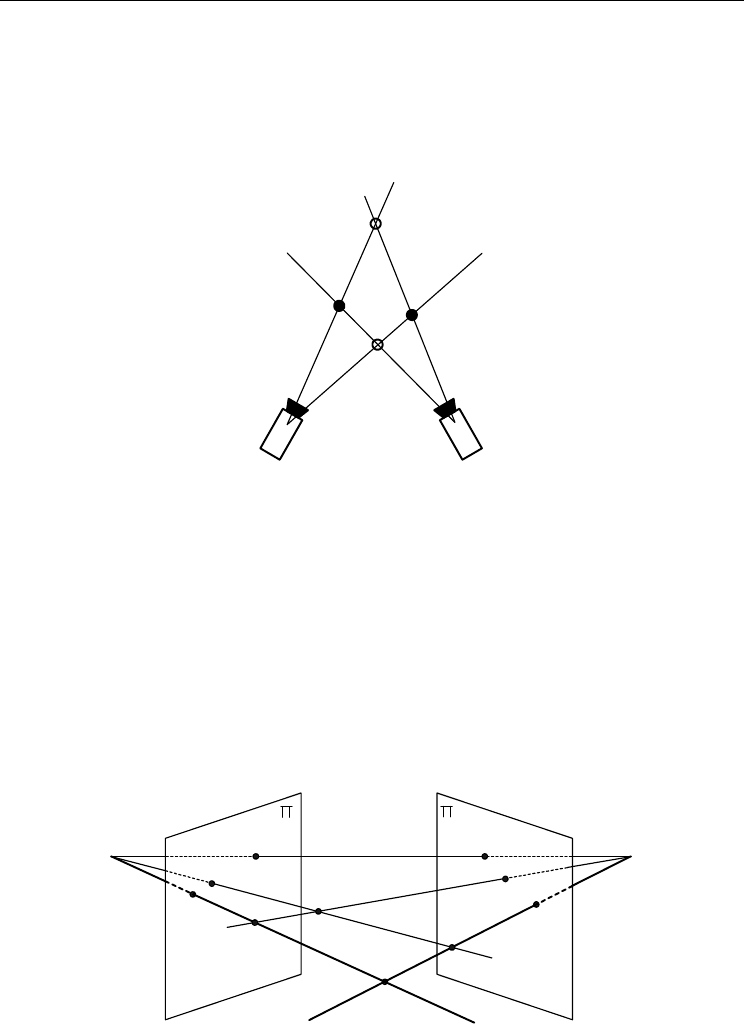
Deghosting Methods for Track-Before-Detect Multitarget Multisensor Algorithms
99
2. Ghosting and basic methods of ghost suppression
2.1 Ghosting
In this chapter are considered sources of ghosts and methods for suppression them using
illustrative examples for usually hard to visualize high dimensionality state spaces. For
single or multiple targets positions estimation two or more sensors are necessary. Using LOS
(Line-of-Sight) triangulation target position and distance estimation is possible.
T1
T2
T3
T4
S1
S2
Fig. 1. Two targets and two ghosts
Assuming two targets and two sensors triangulation fails because there are two possible
solutions:
T1 and T2 – true targets,
T3 and T4 – false targets (ghosts)
or
T1 and T2 – false targets (ghosts),
T3 and T4 – true targets.
If there is no available additional information there is no answer which solution is correct.
This problem is not related to tracking method only to geometrical properties of bearing
only sensors and common to classical and TBD tracking systems. Many methods can be
used for finding solution or eliminate some false assignments.
O
2
O
1
1
2
T
1
T
2
T
3
T
4
Fig. 2. Ghosting in 3D observation space
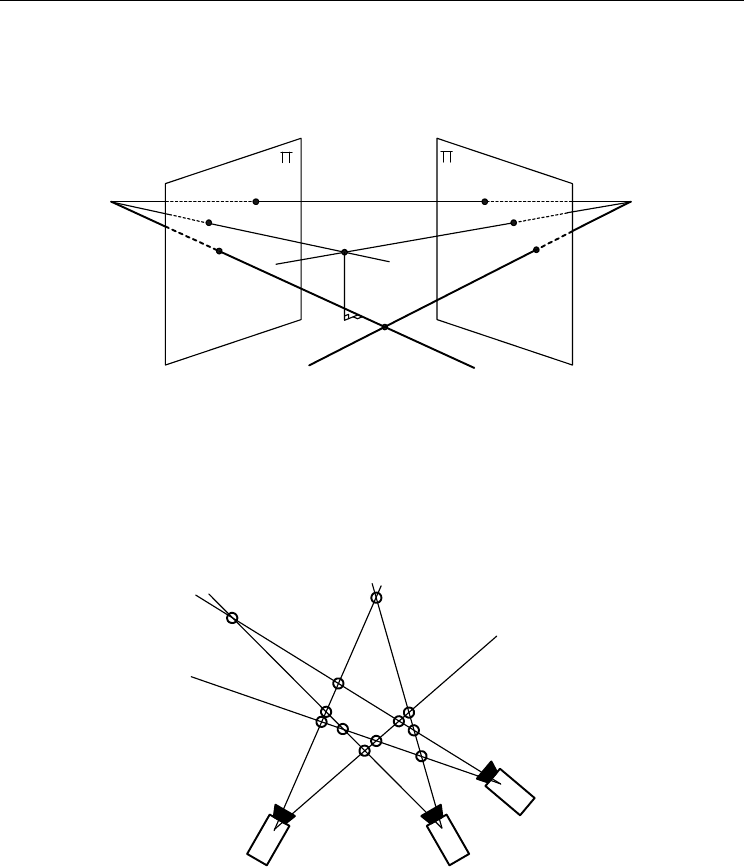
Automation and Robotics
100
If two targets are on common plane (O
1
, O
2
, T
1
and O
1
, O
2
, T
2
) ghost effect occurs (Fig.2). It
can be little surprising that number of ghosts is smaller for 3D space in comparison to 2D
space. If one of the targets is placed outside second plane ghost effect does not occur (Fig.3).
For 2D space ghosts are always (Fig.1).
O
2
O
1
1
2
T
1
T
2
Fig. 3. Two targets and no ghosts in 3D space
2.2 Influence of measurement errors
Angle measurement errors can influent on results for trivial cases. Due to calibration errors
and measurements noises all LOS for single target do not cross in single point (Fig.4). For 2D
object plane all LOS are crossed but not in single point but for 3D space practically they
almost never cross and approximation is required. If there are multiple closely located
targets problem arises.
T1
T2
T3a
T4a
S1
S2
S3
T5
T6
T7
T8
T3b
T3c
T4b T4c
Fig. 4. True objects T3 and T4 are dispersed due to measurement errors
Increasing number of sensors is probably most popular solution, because for true targets
number of LOS crosses increases also. Unfortunately number of ghosts increases also.
Using additional information about targets is promising because it allows eliminate some
ghosts. Amount of eliminated ghosts depends on sensors and object position. Even if not all
ghosts are eliminated it can helps for estimation proper positions of targets using other
algorithms.
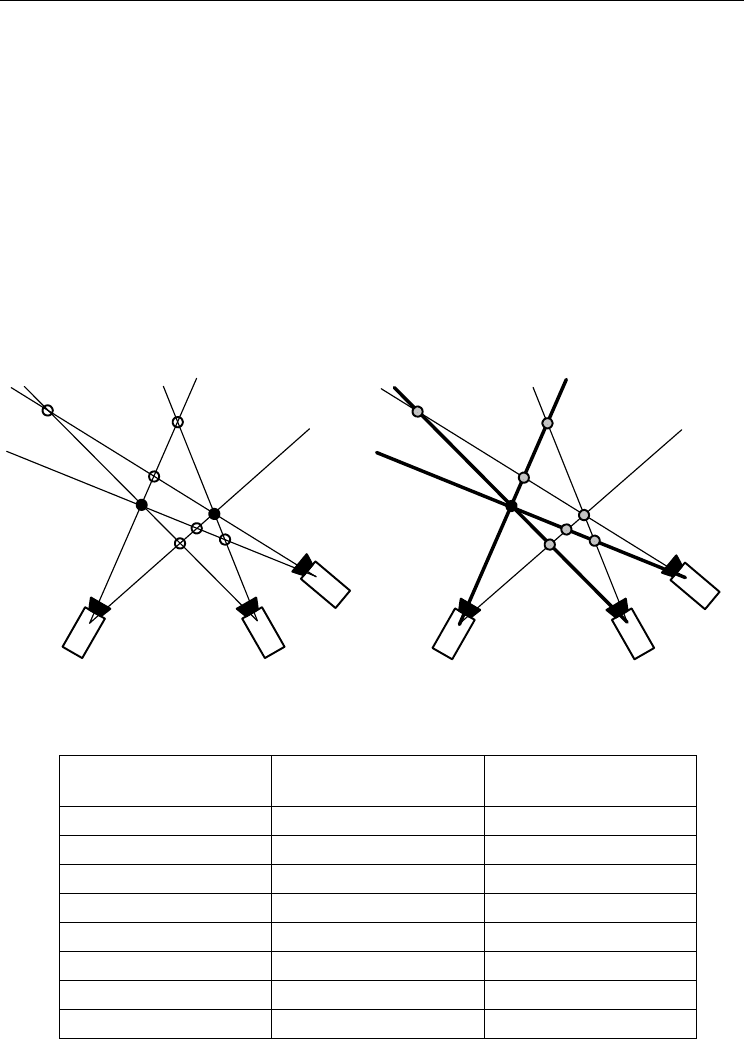
Deghosting Methods for Track-Before-Detect Multitarget Multisensor Algorithms
101
Constraints oriented deghosting methods uses typically knowledge about allowed position,
maximal or minimal velocity, maximal acceleration, direction of movements and others
(Mazurek, 2007). If it is possible all constraints can be used together for best performance.
2.3 Counting and accumulative strategies
For classical methods for every target position (true or ghost) constraints using is
straightforward even if constraints tests are performed for every scan separately. Much
more reliable is extensive tracking where ghosts are tracked and constraints are used for
marking them as ghosts if they forbid constraints limit.
Because TBD algorithms are signal accumulation oriented algorithms they do not consider
LOS crossing as sum of number of crosses but they accumulate signals for particular state
space cell where crossing occurs. It following example is assumed availability of two targets
and three sensors. Signal values registered by sensors for targets are P1=1 and P2=0.5 equal.
True targets are located in T1 and T4 positions. It is worth to be noted that all noises are
omitted so this is very comfortable for any algorithm case.
T1
T2
T3
T4
S1
S2
S3
T5
T6
T7
T8
T1
T2
T3
T4
S1
S2
S3
T5
T6
T7
T8
Fig. 5. Counting strategy (left) and accumulative strategy (right) for two targets and three
sensors
LOS cross point
LOS value
Counting strategy
LOS value
Accumulative strategy
T1 2 1.5
T2 2 1.5
T3 3 3
T4 3 1.5
T5 2 1.5
T6 2 1.5
T7 2 1.5
T8 2 1.5
Table 1. LOS values for Fig.5
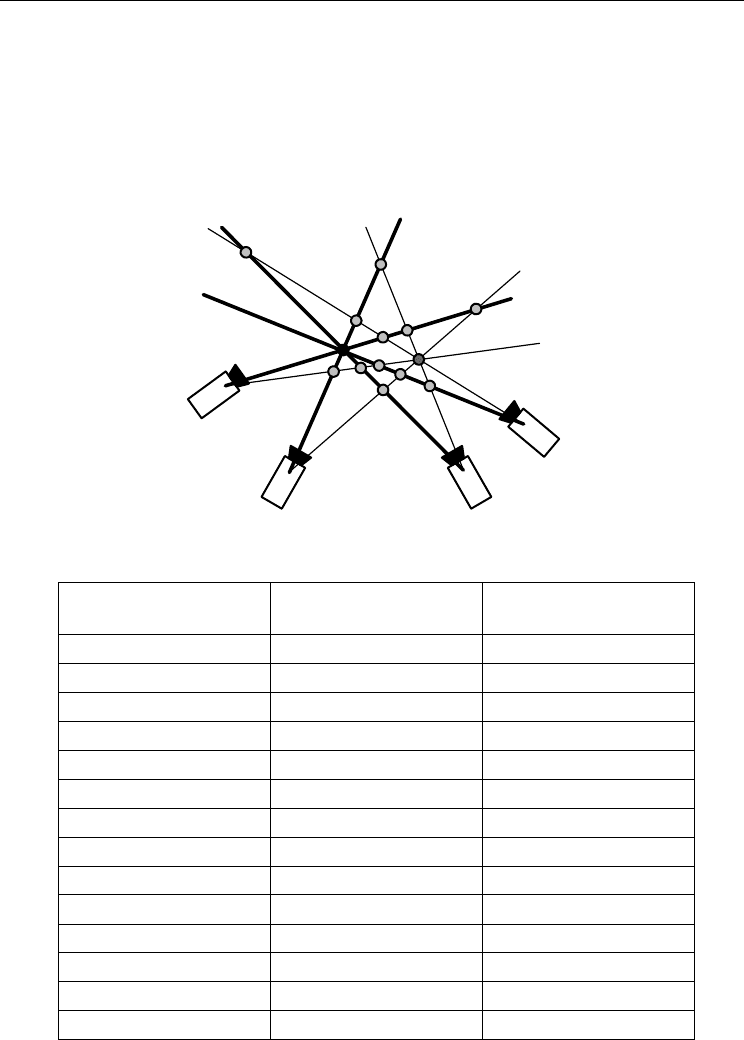
Automation and Robotics
102
This example shows how counting and accumulative strategy algorithms differ. For
counting strategy maximal values corresponding to most probable position of targets and
three sensors help to solve ghosting problem if we know maximal number of targets.
Accumulative strategy fails because T4 value is equal to ghosts’ values and only one target
(T3) is detected as a true target. Even knowledge about number of targets can not help to
solve this simple example.
Only one way for improving accumulative strategy is increasing number of sensors and in
next example is assumed four sensors availability (Fig.6).
T1
T2
T3
T4
S1
S2
S3
T5
T6
T7
T8
S4
T9
T10
T11
T12
T13
T14
Fig. 6. Improving accumulative strategy using additional sensor
LOS cross point
LOS value
Counting strategy
LOS value
Accumulative strategy
T1 2 1.5
T2 2 1.5
T3 4 4
T4 4 2
T5 2 1.5
T6 2 1.5
T7 2 1.5
T8 2 1.5
T9 2 1.5
T10 2 1.5
T11 2 1.5
T12 2 1.5
T13 2 1.5
T14 2 1.5
Table 2. LOS values for Fig.6
